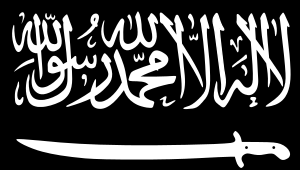Vilayat Galgaycho
| Vilayat Galgaycho Вилайят Галгайче | |
|---|---|
| Participant in Second Chechen War, Insurgency in the North Caucasus | |
|
Flag of the Caucasus Emirate | |
| Active |
2000-7 October 2007 (Under various names) 7 October 2007 – present (As Vilayat Galgaycho) |
| Ideology | Islamism |
| Leaders |
Ilias Gorchkhanov † Akhmed Yevloyev (Emir Magas) (POW) Dzhamaleyl Mutaliyev (Emir Adam) †[1] Arthur Getagazhev (Emir Ubaydullakh) †[1][2] Beslan Makhauri (Emir Muhammad) †[3] |
| Area of operations | Russian North Caucasus (Ingushetia and North Ossetia–Alania) |
| Part of |
|
| Originated as | Ingush Jamaat |
| Allies |
Vilayat Dagestan United Vilayat of Kabarda, Balkaria and Karachay Vilayat Nokhchicho |
| Opponents | Russia, Ingush loyalists, Ossetians |
Vilayat Galgaycho (Province of Ingushetia, Russian: Вилайят Галгайче) is an Islamist militant organization connected to numerous attacks against the local and federal security forces in the Russian regions of Ingushetia and Chechnya in the North Caucasus. Since 2007 it has been a part of the Caucasus Emirate and takes part in the Insurgency in the North Caucasus. The group is thought to be responsible for the deaths of hundreds of people, mostly policemen, military personnel and officials.
History
The origins of the Vilayat Galgaycho can be found during the Ossetian-Ingush conflict. The Ingush are closely related to the Chechens. Both peoples are part of the Nakh tribes, speak Nakh languages and share a common culture, language, religions, and fates. Many of the Ingush lived in the Chechen capital of Grozny during the outbreak of the war and fought along with the Chechen separatists. They never aimed at creating their own separate unit as they were scattered among various Chechen units under the commands of Ruslan Gelayev and Shamil Basayev. These Ingush played a large role in the 1996 siege of Grozny; it took Russian forces over 15 months to capture Bamut, a former Soviet ICBM base, because of the impenetrable construction of the ICBM base installations and some help from Ingush rebels. Many Ingush think that it was Ruslan Aushev, then the president of Ingushetia, who officially opposed Russia's military campaign, and did everything possible not to let Ingush people to be dragged into full-scale war, that the conflict did not spread to Ingushetia and didn't cost additional Russian and Ossetian lives.
After the Second Chechen War broke out, many of the Ingush fighters did not participate in the war as it was viewed as a nationalist movement. Some of them still felt closely related to their destroyed home-city Grozny started rebuilding their military units in Ingushetia, still loyal to Aslan Maskhadov and Basayev. In 2000-2001 the jamaat was reformed along territorial lines in Ingushetia proper, with many units tied to a single city or area. Following the changes in the organisation, all Ingush units started working under the unified Jamaat Shariat (not to be confused with Dagestan's Shariat Jamaat). In 2004 the Jamaat was renamed to Shariat Special Operations Group in accordance with the wishes of Maskhadov; later this changed to Ingush sector of the South-Western Front and, when Abdul-Halim Sadulayev created the Caucasian Front in 2005, Sadulayev referred to it as the Ingush sector of the Caucasus Front. Throughout its many name changes it was mostly referred to simply as the Ingush Jamaat.[4][5]
The group played a key role in the 2004 Nazran raid, an important event which helped to escalate the low-level Ingush insurgency since 2002 into the increasing unrest[6] and eventually into a "civil war", in which more than 800 people died in this tiny republic of less than 500,000 by November 2008.[7] It also took part in the 2005 Nalchik raid, organized by the local Kabardino-Balkar group Yarmuk Jamaat. Following the death of Ilyas Gorchkhanov in Nalchik, the leader of the Ingush Jamaat was Akhmed Yevloyev until his capture in June 2010.[8] Later in 2010, the Vilayat adopted more nationalist rhetoric, vowing to "temporarily" stop killing Ingush policemen[9] and instead attack targets in North Ossetia and help to reclaim the native Ingush lands of Prigorodny District. The group also reaffirmed its loyalty to Umarov following the rejection of his leadership by the Chechen rebels in 2010.[10] The capture or killing of many Vilayat commanders from 2010 onwards coincided with a decline in the insurgency in Ingushetia, with the number of attacks falling substantially over the next 5 years.[11]
In July 2015, a video was released showing the leader of the Ingush Vilayat, Beslan Makhauri, alongside his Chechen counterpart Aslan Byutukayev, pledging allegiance to the Islamic State of Iraq and the Levant (ISIL) leader Abu Bakr al-Baghdadi.[3]
See also
References
- 1 2 "Ingush Insurgency Commander Affirms Support For Embattled Cleric". Radio Free Europe/Radio Liberty. 2013-08-01. Retrieved 2013-08-01.
- ↑ "Bokov: "Emir of Ingushetia" Getagazhev identified among casualties of special operation". Caucasian Knot. 24 May 2014. Retrieved 27 May 2014.
- 1 2 "Ingush Jamaat Loses Another Amir". Jamestown Foundation. 12 November 2015. Retrieved 15 November 2015.
- ↑ The Ingush Jamaat: Identity and Resistance in the North Caucasus Archived August 29, 2007, at the Wayback Machine.
- ↑ "North Caucaus: Who Is Behind The Spiraling Violence In Ingushetia?". RadioFreeEurope/RadioLiberty. Retrieved 4 December 2014.
- ↑ John Pike. "North Caucasus: Increasing Violence In Ingushetia Prompts Crackdown Fears". Retrieved 4 December 2014.
- ↑ "BBC NEWS - Europe - Ingushetia in 'state of civil war'". Retrieved 4 December 2014.
- ↑ "FSB Captures 'Legendary' Ingush Field Commander". RadioFreeEurope/RadioLiberty. Retrieved 4 December 2014.
- ↑ "Ingushetia Militants Announce Moratorium On Killing Police". RadioFreeEurope/RadioLiberty. Retrieved 4 December 2014.
- ↑ United Nations High Commissioner for Refugees. "Refworld - Ingushetia's Islamists Adopt Nationalist Rhetoric". Refworld. Retrieved 4 December 2014.
- ↑ "Why Is The Death Toll Tumbling In The North Caucasus?". Radio Free Europe/Radio Liberty. 10 February 2015. Retrieved 17 February 2015.
External links
- (Russian) Official website
